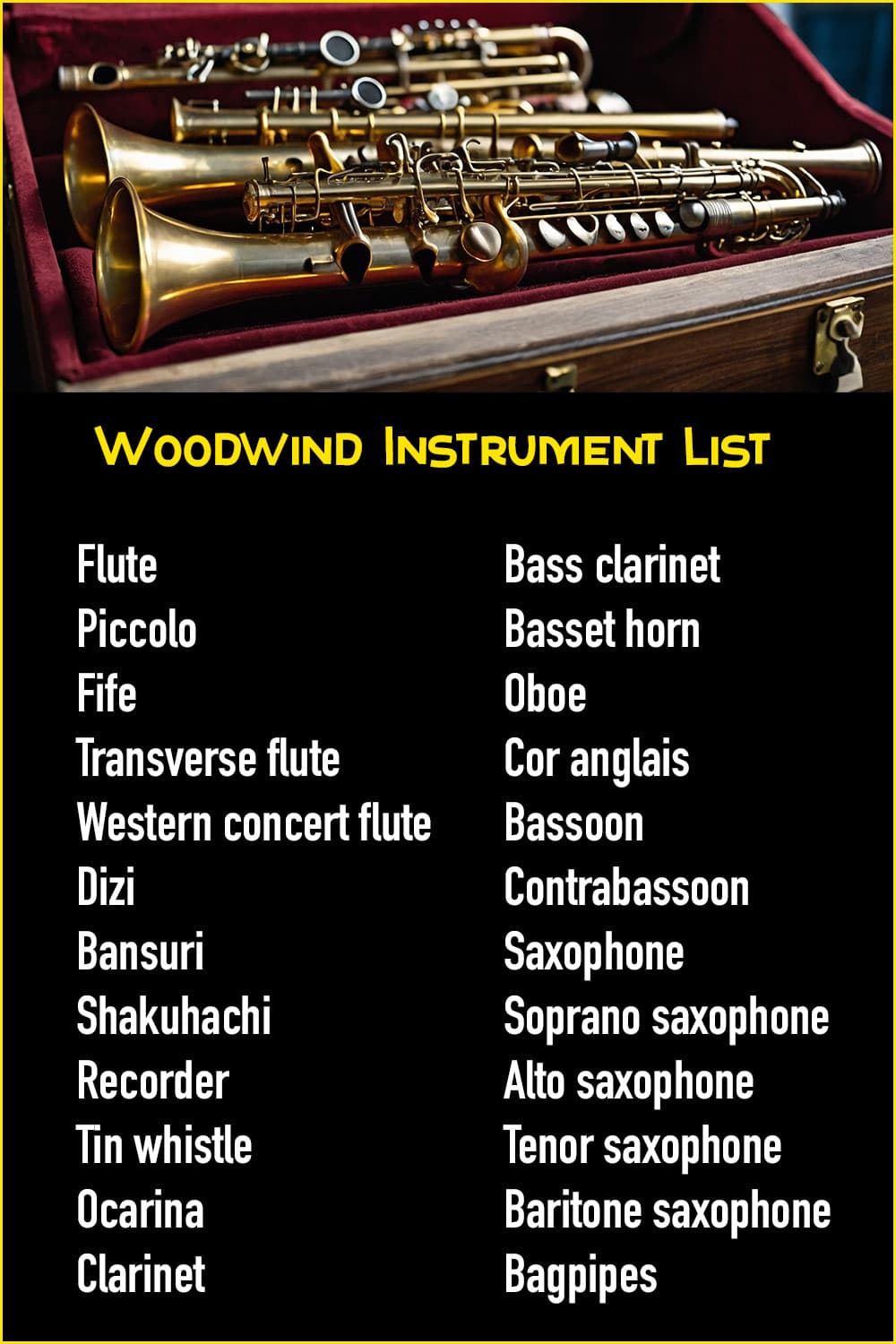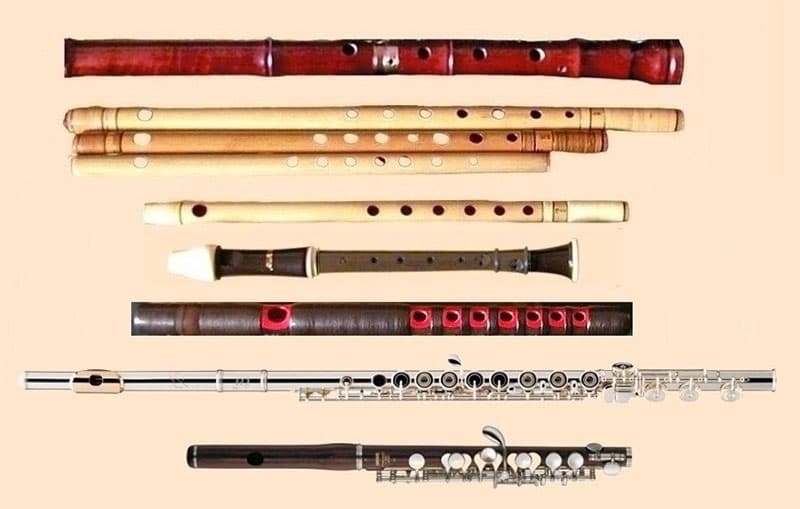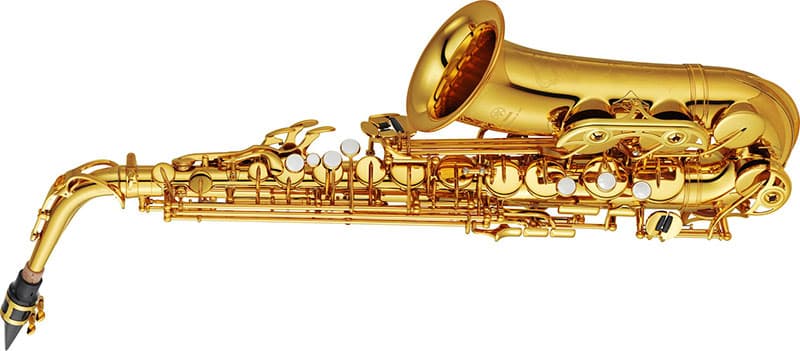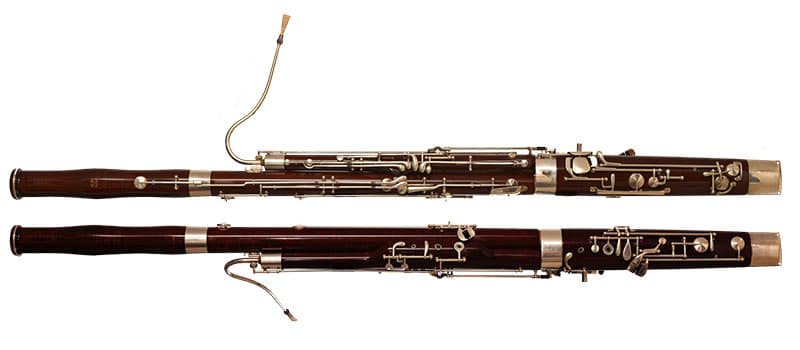What are Woodwind Instruments?
Woodwind instruments are a diverse family of wind instruments that are primarily made from wood.
These instruments include the oboe and clarinet, piccolo, flute, and more.
They also include instruments like the contrabassoon and recorder all which will be on the woodwind instruments list below
The mouthpiece of a woodwind instrument is where the sound is produced.
Some woodwind instruments use a single reed to produce sound, while others use a double reed.
When air is blown across an opening in the instrument, the reed vibrates and creates sound.
By opening and closing different holes on the instrument, the player can change the pitch and produce different notes.
Woodwind instruments are different from brass instruments, which are usually made of brass rather than wood.
Some examples of brass instruments include the trombone and the cornet.
While both woodwind and brass instruments are part of the wind instrument family, they produce different musical tones and have different playing techniques.
Players can explore a wide variety of instruments and learn to play different wind instruments to create unique sounds.
The alto saxophone is another popular woodwind instrument that produces different notes by using a single reed in its mouthpiece.
Understanding the Basics of Wind Instruments
Wind instruments are a family of musical instruments that produce sound by blowing air across a metal mouthpiece.
The two main types of wind instruments include the brass and woodwind instruments.
Woodwind instruments are typically made of wood, with holes for the player to cover or uncover to change the pitch range.
The lowest notes are played by instruments in the wind family such as the e-flat clarinet, while the highest notes are played by instruments in the brass family like the b-flat clarinet.
Some wind instruments, like the flute, can be made of silver and can have 2 to 4 flutes to play the highest notes.
The sound is produced by blowing air into the instrument, and the instrument maker Adolphe Sax is known for creating the saxophone.
Woodwind Instruments List
Here is a list of common woodwind instruments:
- Flute
- Piccolo
- Fife
- Transverse flute
- Western concert flute
- Dizi (Chinese flute)
- Bansuri (Indian bamboo flute)
- Shakuhachi (Japanese bamboo flute)
- Recorder
- Tin whistle
- Ocarina
- Clarinet
- Bass clarinet
- Basset horn
- Oboe
- Cor anglais (English horn)
- Bassoon
- Contrabassoon
- Saxophone (made of metal but considered a woodwind)
- Soprano saxophone
- Alto saxophone
- Tenor saxophone
- Baritone saxophone
- Bagpipes
The main categories are flutes, reed instruments (clarinets, oboes, bassoons, saxophones) and bagpipes.
There are many variations and sub-types within those broader categories of woodwinds.
The basic distinction is that woodwinds produce sound either by blowing air across a hole/embouchure (flutes) or by causing a reed to vibrate with air (reed instruments).
They are called woodwinds because many were historically made of wood, though now metal versions are common too. The bagpipe has a reed and drone pipes as well as other pipes.
Exploring the Flute: A Popular Woodwind Instrument
Woodwind instruments come in a wide variety of shapes and sizes, with the flute being one of the most well-known wind instruments.
The flute is often used in jazz and classical music, and is part of the family of instruments that includes the clarinet, which uses a single reed, and the double reed family related to the oboe.
The flute has a conical bore and is originally made of wood, with the modern flute typically made of metal.
Unlike the holes of most woodwind instruments, the holes on a flute are covered by the players’ fingers, closing the holes to produce different notes.
Flute players blow air across the edge of the mouthpiece to produce sound, creating a unique and beautiful tone that sets it apart from other woodwind instruments.
Woodwind instruments like the flute offer a wide range of musical possibilities, allowing woodwind musicians to explore different instruments within the instrument family.
The flute is a new instrument in comparison to other woodwind instruments due to its unique design, and its use in various genres of music sets it apart from other instruments.
In an orchestra, there are usually 4 flutes, each bringing a distinct sound to the overall ensemble.
The flute is a versatile instrument that can be used in solo performances, chamber music, or large orchestral pieces, showcasing its adaptability and range.
Woodwind instruments may have similarities in their design and function, but each instrument offers a unique playing experience that can be explored by musicians of all levels.
Diving into the Clarinet: A Versatile Reed Instrument
The clarinet is often compared to the flute, which is the oldest instrument in the woodwind family.
While the flute uses a single reed made of metal, the clarinet uses a single reed made of wood.
This key difference in reed used is just one aspect of the instrument design that sets the clarinet apart.
The keys on the clarinet cover the holes to produce different notes, allowing instrument players to discover the different sounds they can create.
In an orchestra, there are typically four flutes compared to just one or two clarinets.
This demonstrates the versatility of the clarinet as an instrument that can be played in various styles and genres.
The early examples of the clarinet date back to the 1700s, showing the enduring appeal of this reed instrument.
The Saxophone: A Well-Known Member of the Woodwind Family
One of the most well-known members of the woodwind family is the Saxophone.
This versatile instrument is often featured in jazz and classical music ensembles.
Unlike the flute, which is the oldest woodwind instrument, the saxophone has a double reed made of metal.
The saxophone has a distinctive sound that sets it apart from other woodwind instruments.
In an orchestra, there are typically only 4 flutes, while the saxophone section can have multiple players.
The saxophone is played by blowing air through the mouthpiece while the fingers on the keys cover the holes to produce different notes.
Whether playing a sweet melody or a soulful solo, the saxophone adds a rich and dynamic sound to any musical piece.
The Bassoon: The Deepest Woodwind Sound
Play the flute is a common suggestion when someone wants to start playing a woodwind instrument.
However, for those looking for a deeper, richer sound, the bassoon is the perfect choice.
The bassoon is known for its distinct, low tones that add depth and warmth to any musical ensemble.
With only 4 flutes in an orchestra, the bassoon stands out as the instrument with the lowest pitch.
Its unique sound is a key component of many orchestral pieces, providing a solid foundation for the rest of the woodwind section.
Flute is the oldest woodwind instrument, but the bassoon offers a different experience for both the player and the listener.
Its deep, resonant sound can evoke a wide range of emotions, making it a versatile and expressive instrument in any musical setting.
Exploring Different Single Reed Options in Woodwind Instruments
When it comes to woodwind instruments, the choice of single reed can greatly impact the sound and playability of the instrument.
Exploring different single reed options allows musicians to fine-tune their sound and find the perfect match for their playing style.
Reeds come in various strengths, cuts, and materials, each offering a unique tonal quality and response.
Choosing the right reed can make a significant difference in a player’s performance, affecting tone production, articulation, and overall control.
Experimenting with different reed options is essential for musicians looking to expand their sound palette and achieve their desired musical expression.
Whether it’s a traditional cane reed or a synthetic alternative, the possibilities for customization are endless when it comes to single reeds.
How Do Woodwind Instruments Produce Sound?
Woodwind instruments produce sound by using a column of air that is manipulated by the player.
When the player blows air through a mouthpiece or reed, the air vibrates and creates sound waves.
The size and shape of the instrument, as well as the player’s technique, all play a role in the sound produced.
The air column inside the instrument can be made shorter or longer by opening and closing keys or holes. This changes the pitch of the sound produced.
Additionally, the material and construction of the instrument also affect the sound quality.
The vibrations created by the air column eventually exit the instrument through a bell or opening, producing the sound that is heard by the listener.
Understanding Pitch and Tone Production in Woodwind Instruments
Understanding Pitch in woodwind instruments is crucial for producing accurate and in-tune tones.
The pitch of a note is determined by the length of the air column inside the instrument.
By opening and closing different key combinations, the player can change the length of the air column and thus alter the pitch of the sound produced.
Additionally, the tone production in woodwind instruments is influenced by factors such as the reed’s vibration, the shape of the instrument’s bore, and the player’s embouchure.
These factors affect the quality and timbre of the sound produced.
To achieve a consistent and controlled tone production, woodwind players must have a strong understanding of how pitch and tone are produced in their specific instrument.
Image Credits:
- Gisbert K
- Yamaha Corporation
- Gregory F. Maxwell












